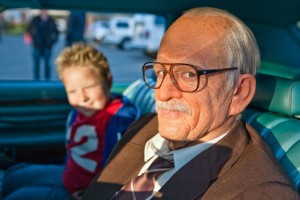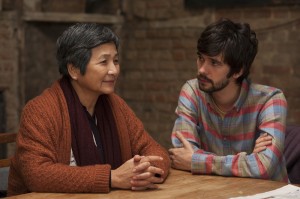
There are two kinds of genre cheapie. The first kind is sloppy, cheap, kitschy, plasticky, wallowing in its own artificiality. Some of the movies are great, even though the craft or the money or the vision isn’t always there. The other kind is scrappy and resourceful, turning its limitations into strengths through sheer vision and creativity. There’s a fundamental understanding of what makes a story or an image tick that it becomes its own aesthetic code. Gun Crazy was like that, lithe in form, boiling down the angst and melodrama of noir to it’s most elemental metaphor: the phallic gun. Detour was like this too, able to construct a convincing inner/outer underworld from the sparest parts. To that list we should add Dementia, a jumpy, jagged psychic blast of jazz horror, and a secret high-water mark in the “Los Angeles is a terrible place for your own well-being” subgenre of filmmaking that encompasses everything from Sunset Boulevard to David Lynch.
Dementia (also known as Daughter of Horror) feels like a cursed movie. It sits at the intersection of tail end of the original American cycle of film noir, the very edge of Hollywood’s Poverty Row, and the deep dark recesses of the collective urban unconscious. Nearly everything about it suggests that it was beamed in from an alternate dimension; writer-director-producer John Parker basically disappeared from the face of the earth after making it. Lead actress Adrienne Barrett has only one other known acting credit, a bit part in an Australian drama directed by Councillor Dillard from the Matrix sequels that was made 31 years after Dementia was. In fact, no one involved here really did a whole lot of anything before or since the time Dementia initially found its way onto a couple of screens in New York in 1955. Only character actor/poor man’s Orson Welles Bruno VeSota, bandleader Shorty Davis, and lensman/Ed Wood acolyte William C. Thompson seem to have escaped this movie’s dark spiral. The only think spookier than the cold trails on the crew’s careers is its vision of anguish and guilt projected onto a crumbling city, a vision distressing enough to have been caught in censorship limbo for two years prior to its release.
Parker, if only this one time, proved that he was fluent in the language of nightmares.There’s something just off about each shot that doesn’t read like a lack of quality control. Every Dutch angle, expressionistic match cut, and off-kilter shooting angle compounds the nerviness of the proceedings. Also key to the atmosphere is the lack of dialogue: in the truest sense, this is a film of images, or sounds. The only sounds you’ll hear that could conceivable come from a human mouth are creepy, reverbed-out laughter and the anguished cries of the protagonist, only known as the Gamin (Barrett). Otherwise, the soundtrack is all creaky Foley work reminiscent of a Halloween sound-effect record and rowdy dive-bar jazz courtesy of Davis and his Giants.
But there is also just a great deal of effectively off-putting imagery. A long, uncomfortable close-up of VeSota gorging himself on chicken wings. And, as hinted above, lots of hand imagery. Hands pointing accusingly, hands jutting from every corner of the frame to form a cluster of fingers, hands being cut off to the sound of a bowed bass doing its best impression of a chain saw digging into a tree trunk. There’s a besuited faceless apparition ushering the Gamin to the gravestones of her parents, including her abusive lout of a dad (Ben Roseman, total non-Dementia acting credits: four). Now, the man is just wearing black pantyhose over his head, and the flashbacks to the Gamin’s past are all done in the same graveyard as if they were being reenacted there, and hell, the man who plays the father also shows up as a cop later in the film. All these elements, while nominally the result of the constraints Parker and company found themselves with, all contribute to the disorienting impossible-space vibe of the film. It’s hell on a shoestring, and it’s a sight to see.
—
Dementia is available on home video.
Directed by John Parker; written by John Parker; starring Adrienne Barrett, Bruno VeSota, and Ben Roseman; 61 minutes.



 Derek
Derek
 Isabelle
Isabelle